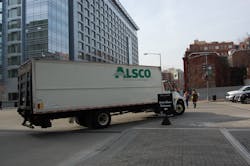The rapid growth of e-commerce will continue to reshape the retail landscape and the consumer delivery supply chain in some positive ways for trucking, an annual study argues; especially in terms of forcing inventories closer to customers, thus driving up demand for more localized and regional transportation options.
Yet the Home Delivery & Final Mile Services: Consumer Insights and Market Update compiled by global consulting firm AlixPartners LLP also finds that the demand for “free shipping” of goods bought online continues to increase as well, with consumers expecting faster delivery times, too – two issues that could pose a problem for trucking firms seeking to turn a profit in the retail segment of e-commerce.
“Free-shipping: this is what matters and it is here to stay,” noted Marc Iampieri, one of AlixPartner’s directors, during a conference call hosted by Stifel Capital Markets late last week.
“People want more, they want it for less, and they want it faster,” he said, pointing out that the expected “wait time” for free shipping of online goods is now an average of 4.8 days versus 5.5 days back in 2012, according to the firm’s latest survey.
“The old saying that ‘beggars can’t be choosers’ doesn’t seem to be true anymore – apparently they can,” Iamperi noted.
He added that “free shipping” is also now an “order qualifier” in the e-commerce world, with 97% of the consumers surveyed by AlixPartners saying it impacts their purchase decision, with 75% saying it “greatly” impacts their ordering decision.
“We see that [free shipping] now as ‘table stakes’ to be in the e-commerce market,” said Joshua Hubbard, another AlixPartner director, on the call.
He added that the major growth occurring in the retail space is happening in what’s now“What you see now is that while e-commerce is only just over 7% of all retail sales, it is experiencing a 17% compound average growth rate (CAGR) versus just a 3% CAGR for non-e-commerce retail business between 2000 and 2015,” Hubbard said. “That is where we see retail growth occurring; in e-commerce.”
The transportation piece of the e-commerce market is large as well, worth $80 billion, according to AlixPartners’ numbers, with 6% of that in “last mile” delivery business alone.
The volume of e-commerce is rapidly increasing as well, along with a wider assortment of goods being ordered, Hubbard emphasized, with average orders per year jumping from 9.8 in 2012 to 14.7 this year. “We’re seeing a little bit of a plateau in the frequency of ordering [but] with more areas of growth: health/medical goods, home improvement/hardware, and home furnishings,” he noted.
Online consumers have been historically wary to order larger, bulky items, Hubbard added, but now some less hesitant to order large appliances, electronic, and even furniture via the Internet.
What does all of that mean for trucking?For starters, Iamperi doesn’t envision a lot of TL deliveries to consumers in the e-commerce space. “That being said, though, Covenant Transport, for example, is focusing more on the retail space and that has helped them financially,” he pointed out. “It’s an area more for segmenting the customer base; it is still an area TL should keep an eye on for opportunity.”
By contrast, e-commerce freight is more in line with LTL carrier equipment as many have lift gates on their trailers. “They could offer services here, but regional and smaller players would be a better fit; not the huge super-national LTL carriers,” Iamperi said.
Third party logistics (3PL) companies could see a big e-commerce opportunity in what Iamperi dubs “Tier 2” cities such as Indianapolis. “This is certainly an area where they [3PLs] can play by offering ‘differential’ services,” he said. “We also see opportunity for commercial real estate in logistics – there’s already been some decent growth.”
That’s because as inventories need to move closer to customers, more warehouse space will be needed. “It’s a lower cost to have more [fulfillment centers] in your footprint while paying for non-expedited delivery,” Iamperi emphasized.Could there be any impact on the truck driver shortage from those e-commerce shipping trends? Iamperi isn’t sure.
“It’s a bit of a different demographic, last mile versus over-the-road,” he explained. “Many last mile companies are using vans with non-CDL drivers, so recruiting for starters is a little different.”
Yet even in the heavy goods segment of e-commerce delivery, such as furniture, Iamperi said delivery companies speak of finding drivers as a “challenge,” not as a “barrier,” to growth.
“Drivers are home every night and with straight trucks [and vans] get better compensation,” he emphasized. “[Last mile] offers a very different lifestyle compared to over-the-road.”
About the Author
Sean Kilcarr
Editor in Chief
Sean Kilcarr is a former longtime FleetOwner senior editor who wrote for the publication from 2000 to 2018. He served as editor-in-chief from 2017 to 2018.



